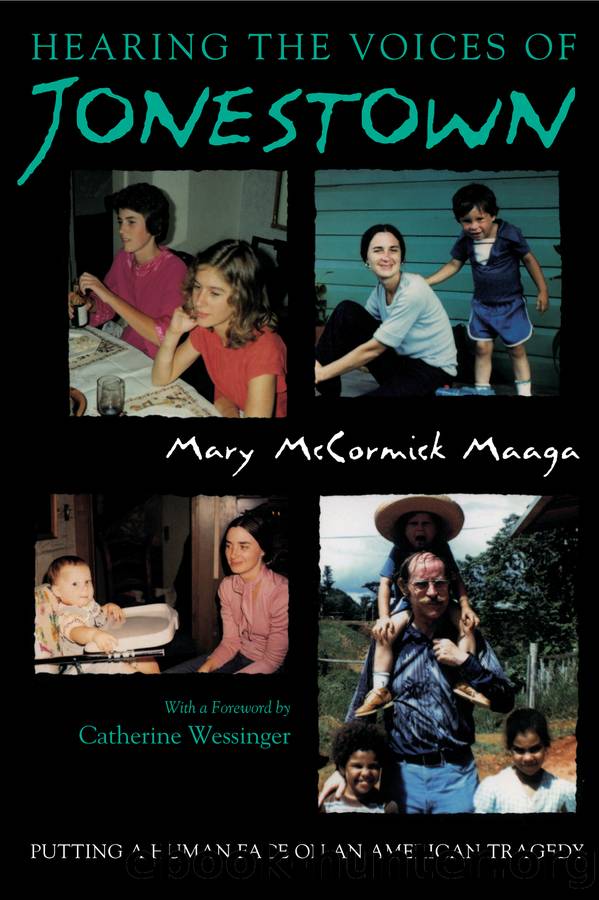Hearing the Voices of Jonestown by Mary McCormick Maaga

Author:Mary McCormick Maaga
Language: eng
Format: epub
Publisher: Syracuse University Press
Published: 2020-03-09T00:00:00+00:00
6
From Jones the Person to Jonestown the Community
Peoples Temple went through a period of rapid social change after relocating to Jonestown, Guyana. Most interpreters of Peoples Temple have commented on how the isolation of Jonestown promoted dependence on Jim Jones and heightened the already well-developed âinsider-outsiderâ ideology of the organization. The shift that took place, however, was actually more dramatic and quite different from what this analysis suggests. I argue that the social change that occurred within Peoples Temple because of the move to Jonestown actually constituted a move away from Jim Jonesâs control rather than toward greater dependence on him. Jonesâs power unraveled within his own movement and authority shiftedâperhaps including the authority to carry out the suicidesâfrom a combination of Jones and his leadership circle to the leadership circle alone, specifically the women. The shift was away from an emphasis on Jones to an emphasis on the Peoples Temple community as a whole. It also solidified a transition in authority from the sect leaders to the new religious movement leaders that had already substantively taken place during the outreach to urban black church members in the early 1970s.
Jonesâs Shifting Authority
Jonathan Z. Smith has named the change that took place in the move from California to Guyana as a shift from âsubversive spaceâ to âutopian spaceâ (J. Z. Smith 1982, chap. 7). Peoples Temple in California had provided for its members, especially its black church members, what the âestablishment spaceâ would not or could not. While openly participating in political and religious activism, Peoples Temple was also, less visibly, organizing its own oppositional social system. âInternally, it was a counterpolis. It had its own modes of leadership, its own criteria for citizenship, its own mores and laws, its own system of discipline and punishmentâ (115).
There were aspects of this oppositional social system that the mainstream public was bound to object to once they learned of them, including disciplinary boxing matches, âcatharsisâ meetings, and faked healings and discernments. Jones himself admitted that deception was involved in some of the healings he performed. âPeople pass growths and then by sleight of hand I started doing itâand that would trigger others to get healed. It was kind of a catalyst process, to build faithâ (Hall 1987, 20). In July 1977 New West Magazine (Kilduff and Tracy, 1977) published an article âInside Peoples Templeâ based upon the testimony of ten apostates which alleged that numerous abuses of power were taking place within Jonesâs organization. Most of the accusations centered on Jim Jones specifically and were interpreted by some as politically motivated because Jones up to that point had been a well-respected and powerful participant in the liberal San Francisco political establishment. Especially damaging were reports of abusive disciplinary proceedings during which a person who had violated a Peoples Temple policy was made to box with a stronger loyalist (Reiterman 1982, 259â60). There were also allegations of psychological abuse involving all night catharsis sessions during which members would âconfessâ to desires and behaviors ranging
Download
This site does not store any files on its server. We only index and link to content provided by other sites. Please contact the content providers to delete copyright contents if any and email us, we'll remove relevant links or contents immediately.
| Baha'i | Cults |
| Demonology & Satanism | Eckankar |
| Egyptian Book of the Dead | Freemasonry |
| Messianic Judaism | Mysticism |
| Scientology | Theism |
| Tribal & Ethnic | Unitarian Universalism |
The Four Agreements by Don Miguel Ruiz(6640)
Breaking Free by Rachel Jeffs(4175)
The Hatha Yoga Pradipika (Translated) by Svatmarama(3235)
120 Days of Sodom by Marquis de Sade(3185)
Member of the Family by Dianne Lake(2303)
The Tao of Physics by Fritjof Capra(2231)
The Psychedelic Gospels: The Secret History of Hallucinogens in Christianity by Jerry B. Brown(2122)
The Road to Jonestown by Jeff Guinn(2021)
Going Clear: Scientology, Hollywood, and the Prison of Belief by Lawrence Wright(1940)
Going Clear by Lawrence Wright(1927)
Uriel's Machine by Christopher Knight(1866)
The Grand Grimoire: The Red Dragon by Author Unknown(1761)
The Gnostic Gospel of St. Thomas by Tau Malachi(1739)
Key to the Sacred Pattern: The Untold Story of Rennes-le-Chateau by Henry Lincoln(1596)
The Malloreon: Book 02 - King of the Murgos by David Eddings(1562)
Waco by David Thibodeau & Leon Whiteson & Aviva Layton(1531)
The New World Order Book by Nick Redfern(1527)
Animal Speak by Ted Andrews(1521)
The Secret of the Temple by John Michael Greer(1467)
